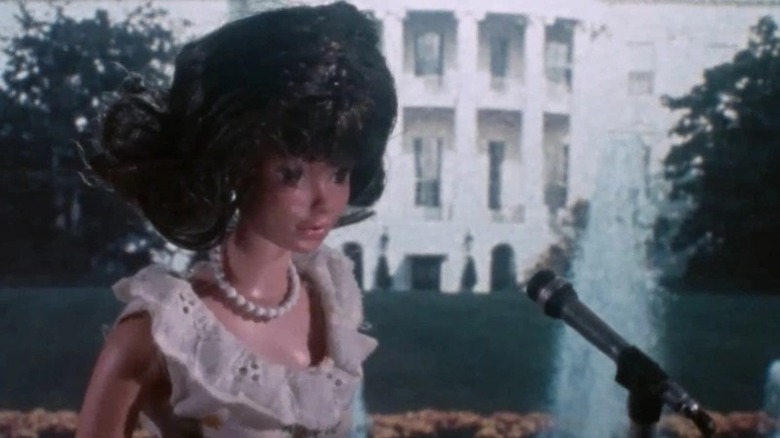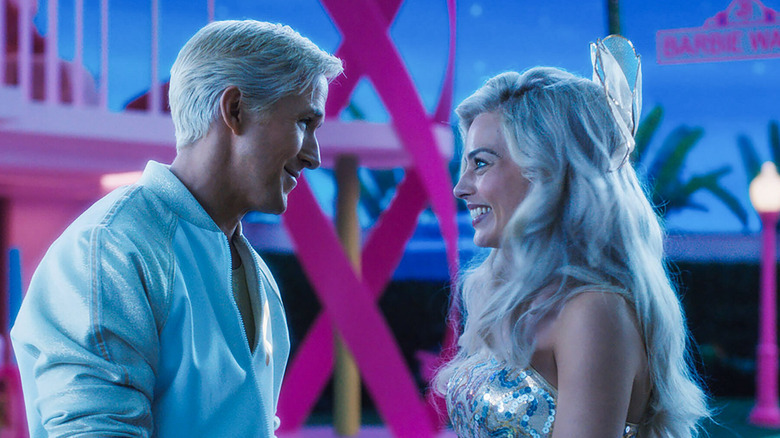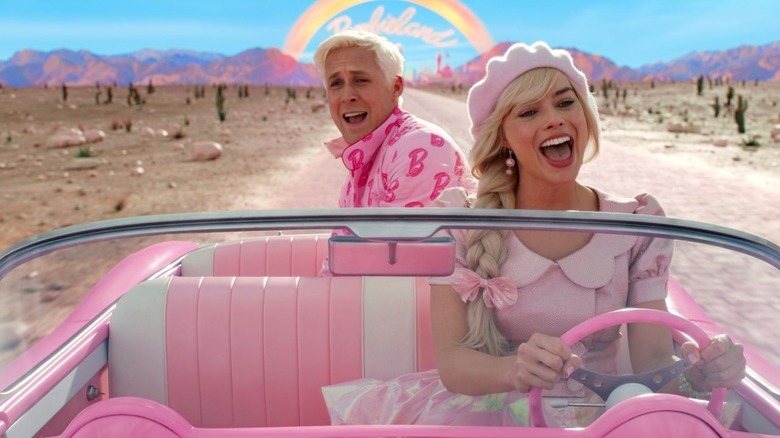Producers Were Afraid Greta Gerwig's Barbie Would Be A Todd Haynes Repeat
This article contains spoilers for "Barbie."
What if I told you that Greta Gerwig's 2023 summer blockbuster "Barbie" wasn't the first movie that explored the complex feminist issues with Mattel's world-famous doll?
"May December" director Todd Haynes started as an experimental filmmaker who made waves in the underground cinema scene back in the '80s with his stop-motion music doc, "Superstar: The Karen Carpenter Story." Haynes' film might not have been as record-breakingly successful as Gerwig's was, but it helped jumpstart what became an incredibly successful career for the director. "Barbie" was the first corporate-sanctioned film that explored the doll's complicated relationship with women and their bodies, but Haynes technically did it first back in '87. Mattel and Warner Brothers executives were even concerned that Gerwig might get a little too inspired by Haynes' dark take on the toy.
"Barbie" is set in the fictional world of Barbieland, where everything is perfect — until, all of a sudden, it isn't. The stereotypical blonde-haired Barbie, played by Margot Robbie, is forced to go to the real world to investigate why her plastic utopia is falling apart. When a subordinate Ken (Ryan Gosling) tags along and discovers that the real world is a patriarchy, not a matriarchy, Barbieland is thrown into utter chaos and Barbie is forced to make it right while battling existential dread.
Gerwig's film tells the story of Barbie, but "Superstar" tells its story through her. The unconventional short follows the life of Karen Carpenter, the wildly famous '70s pop star who died from anorexia at just 32 years old. Carpenter's star shone bright and burned out fast, making her death the subject of tabloid fodder and intrigue for years to come. Haynes' visceral yet campy exploration of her passing using Barbie dolls instead of actors turned out to be exactly what America hungered for.
Superstar tells the tragic story of Karen Carpenter with Barbie dolls
Gerwig's mega-hit balances humor and tenderness, bringing levity to dark subject matters. In its own way, "Superstar" strikes a similar balance. It's easy to find humor in its unorthodox approach, but the film is just as moving as it is ironic.
Even though they tell entirely different stories, both movies explore — either directly or subtextually — the correlation between Barbie dolls and women's body image. As middle school mean girl Sasha explains in the 2023 movie, Barbies represent "unrealistic physical ideals" and "destroyed women's innate sense of self-worth."
"Superstar" was removed from circulation shortly after its release when Karen's brother Richard successfully claimed copyright infringement for The Carpenters' unauthorized soundtrack. However, Gerwig caught a "bootleg of it at Cannes," giving her a chance to see "the original 'Barbie' movie," she told The Hollywood Reporter. She and Haynes got the chance to speak about their shared Mattelian muse in an actors' roundtable.
"It's a wonderful thing that we're sitting at the table right now because I think genuinely, you made [the 'Barbie' movie's backers] nervous about the possibilities about what it could be," the "Lady Bird" director confessed to Haynes.
Even though he could see some similarities, the "Carol" director didn't understand how anyone could ever truly compare Gerwig's take on the doll to his own.
"Are you kidding?" he responded. "I mean, my use of Barbies was as a subtext to a story about how women's bodies are commodified and this incredibly heartbreaking story of a young woman suffering from anorexia nervosa. But you took on the cultural meaning of Barbie, and you exploded it and also made a concoction [...] a confection that everybody could share."
Gerwig used Haynes' film as a reference for Barbie
"Barbie" might be a radically different film than Haynes' "Superstar," but that doesn't mean that Gerwig and her writing partner-slash-husband Noah Baumbach didn't draw on the 1987 flick for inspiration. The actor-turned-filmmaker insisted that "the approach in that movie that [Haynes] took, it was something that Noah [Baumbach] and I talked about," she continued.
Despite executives' concerns about using the experimental film as a reference point for the multi-million dollar blockbuster, Gerwig wanted to honor Haynes' part in Barbie's cinematic legacy. "The way [Haynes] used Barbies was part of the cultural history of Barbie," she added. "But I think [the execs] were like, 'Are you going to do that thing that he did?' And we're like, 'Well ...'" They may have been reluctant to embrace this experimental influence at first, but Mattel got on the ride with "Barbie" quickly.
There's no denying that the two films are wildly different. But on top of tackling body image issues and oscillating between irony and sincerity, the two features also share a complicated relationship with feminism. Barbie is an inherently complex character in this department, having historically been criticized by feminist thought leaders while continually attempting to better represent the ever-changing definition of the modern woman.
While "Superstar" and "Barbie" both explore feminist issues, both directors resist the ideological label. Gerwig described the 2023 musical comedy as being "humanist above all else" in an interview with Rolling Stone. Both her and Haynes' films have been celebrated by feminists, but some more radical feminists have criticized them for failing to adequately represent the movement's values. A "narrow and dogmatic side of feminism" criticized Haynes for employing humor to demonstrate the horrors of anorexia, he said in an interview with Sheryl Farber in 1989.
There aren't any actual Barbie dolls in Superstar
"Superstar" might be the "original 'Barbie' movie," to use Gerwig's words, but the 2023 film is the definitive text on the controversial toy. This isn't just about copyright and corporate sanctions — even Haynes has admitted that Gerwig's film explores the essence of the doll, while his film simply employs Barbie as a symbol of wholesome mid-century American culture.
Like Barbie, Karen Carpenter represented the American ideal for a short time. She and her brother's sweet, naive new sound represented a return to innocence after the era of free love and rock'n'roll in the late '60s. They embodied an impossible promise, much like Barbie, and the late musician's fatal body issues only created another connection between her own image and the doll's. However, Haynes didn't even use actual Barbies in the stop-motion film:
"I found the dolls at flea markets. I don't think they were actually Barbie dolls. These were dolls that were extremely thin already but the faces were kind of round so I wanted to carve down the cheeks and then cover it over with pancake makeup and have very creepy effects [...] in fact none of them are literally Barbie dolls. The doll that portrays Karen is the Tracy doll, a Mattel product who's the dark-haired current Barbie friend on the market. A Ken doll does portray Richard but he has various wigs and hairpieces throughout the film and by the end of the film we changed his face a lot so it's no longer a Ken doll."
Barbie and Superstar both explore our relationship to dolls
The similarities keep coming — "Superstar" and "Barbie" also share an examination of the human impulse to project one's emotional world onto Barbie dolls. The crux of the plot in "Barbie" is that America Ferrera's character has linked her psyche with Stereotypical Barbie, causing her to experience the same existential dread and fear of aging. In this way, the narrative directly tackles the interesting emotional attachments that people can form with inanimate objects.
Haynes explores the same concept in "Superstar" by using dolls as actors. The audience takes the place of Ferrera's character and, just like she does to Stereotypical Barbie, we project human emotions onto the unchanging face of a doll.
The "Safe" director "was really intrigued with the idea of doing a fairly straightforward narrative drawing on pre-existing popular forms, but simply replacing real actors with inanimate objects, with dolls," he continued, "and being very careful with it and detailed in such a way that it would provoke the same kind of identification and investment in the narrative as any real movie would."
The Oscar-nominated filmmaker felt that using dolls would make the audience question the way they identified with the artificial emotions of actors in movies, or even with pop stars like Karen. The viewer's engagement with "Superstar" is emotionally attached, but should be mulled over critically.
"Maybe that's what happens when we see movies, it's more the forms and the structures that they take that provoke the emotional responses [...]" the filmmaker suggested. "We were watching shadows on the wall carefully fitting into pre-existing forms that we know very well, that we still cry and laugh at as if it were a real person."
And between the dolls and the poor quality of the illegally uploaded bootleg, "Superstar" really does feel like a cave painting.
Are Superstar and Barbie feminist films?
Just like Barbie, Karen also has a famous male counterpart in her life — her brother, Richard, who is actually portrayed by a Ken doll in "Superstar." After Ken goes to the real world and learns about the patriarchy, he too seeks to control Barbie and flip the scales of power in Barbieland after being outshined by Barbie for so long. Like Ken, Karen's older brother took a reluctant backseat to Karen's shining stardom, even though he was the first musician in the family. His attempts to control Karen, albeit well-intentioned, contributed to her mental decline.
Even though both Ken and Richard represent oppressive forces for Barbie and Karen, they aren't straightforward villains. Richard struggles with addiction to quaaludes during most of Karen's illness and generally tries his best to look out for her. His addiction sadly makes him look hypocritical when he tries to confront his sister about her health problems.
"I love the part in 'Superstar' when Karen turns around and she says, 'I am sick, Richard,'" Haynes recalled, "and he says, 'What do you mean sick, mentally?' And he looks so much sicker than she does."
While Ken's intentions aren't quite so pure, his motivations for trying to oppress Barbie are even more understandable than Richard's. He and his fellow Kens had been put down and pushed around for years, which complicates the feminist message of the movie a bit. "Barbie" suggests that "any kind of hierarchical power structure that moves in any direction isn't so great," Gerwig clarified to Rolling Stone.
These two wildly different "Barbie" movies deliver a nuanced feminist message about bodily autonomy while questioning the human relationship to dolls in general. Instead of simply criticizing Barbie for negatively shaping women's beauty ideals, "Superstar" and "Barbie" alike both ask — why does a plastic doll have that kind of power?





